| |
|

|
 |
 |
 |
| |
 |
History
During the middle of the 19th century the Government
of Victoria voted the sum
of £5000 for the construction of a large equatorial
telescope to be erected at the
Melbourne Observatory, Australia.
|
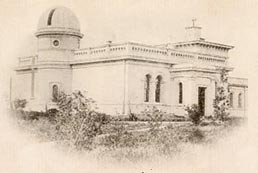
The construction of the grand instrument
was entrusted to Mr.Grubb, F.R.S., of Dublin, Ireland. At the
commencement
of the year 1868 the telescope was completed, and examined
by a committee of the Royal Society, made up of Lord Rosse,
Dr.Robinson and Warren De La Rue. In their report they
expressed their opinion that the equatorial was a masterpiece
of astronomical mechanism.
The Earls of Rosse had a
long history of building larger and
larger telescopes the final effort being :LEVIATHAN: with
a speculum mirror 6 feet in diameter. The telescope has been
restored with an aluminium mirror. { the original speculum
mirror remains with the Science Museum London, England.
Dr.Robinson was Astronomer
Royal for Ireland and
an obsessed man in regard to speculum mirrors.
Warren De La Rue had wide experience in photography
and through the telescope in particular.
The Great Melbourne telescope
was a Cassegrain, being of a kind recommended by the Royal
Society of England. The mirrors, two, being supplied, in case
of accident, were four feet in diameter and made of speculum
metal , four and a half inches thick, thirty feet six inches
in focus, and resting in their giant mirror cell on Mr.Grubb's
system of hoops; the whole system of suspension
and levers weighed altogether nearly two tons .
|
 The Southern Cross from a sketch of 1875
The Southern Cross from a sketch of 1875 |
|
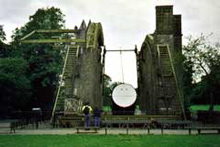 |
|
|
General view of Leviathan on the North
South Meridian
|
|
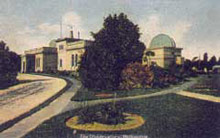 |
View of the main building and
the Astrograph Dome to the right for the telescope that
was
used in the Cart du Ciel project. |
 |
| Eye end of the six foot "
Leviathan" |
|
|
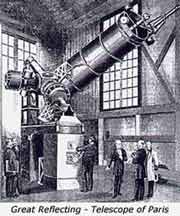 |
| Telescope inside rotating shelter
|
|
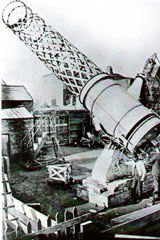 |
| *Mr.Grubb at the eyepiece during
testing. Some planets and stars could be observed during
the day. |
|
|
|
 top top
"An application was
made through the Secretary of State for the Colonies to the
Royal Society of London for their opinion, and the President
and Council of that body, after a very full consideration
and a long correspondence with the most eminent practical
astronomers of the day, recommended -
(a) That the telescope be a reflector, with an aperture of
not less than 4 feet;
(b) That the large mirror be of speculum metal ;
(c) That the tube be constructed of open work and of metal"
1n 1868 the completed telescope
arrived in Australia, reaching Melbourne in November of that
year; it was ready for work by the end of June 1869, and the
observations commenced in August of the same year.
The Great Melbourne Telescope
was for many years after 1869 employed in the revision of
nebulae and clusters in the hope of recording any changes
which may have occurred since the time of Sir John Herschel's
observations of the same material at the Cape of Good Hope
in the years 1834-38.
The G.M.T. was exposed to
the sky during observations and the slightest wind made observing
difficult with the high focal ratios from the cassegrain system.
While photography was almost
impossible, drawings arrived in Melbourne for a dome from
Mr.Grubb but were never used.
About the same time there appeared in Paris
a 47 inch diameter telescope using silver on glass.
This instrument was protected by a rotating circular room /shelter.
Observations were taken at
the top of a spiral stair case some 40 feet above the ground
level.
 top
top
Great
Melbourne Telescope was destroyed with other
Telescopes during the bush fires of January 2003

view of the Stromolo Observatory
Herald Sun
Mr.Greig,
I'am just ending one
article for my french Astronomic society magazine.
The first part is about Stromlo story, and its instruments
review. Of course,
I wrote on the Great Melbourne telescope singular story.
In conclusion,
I illustrate the disaster through last images resulting
of the Canberra fires.
The "Société Astronomique de France"
sent a message of sympathy to
Penny D. Sackett (Director of Research School of Astronomy
and Astrophysics
and Mount Stromlo and Siding Spring Observatories) and
are deciding on a donation
to help on rebuilding the Mount Stromlo Observatory.
Thanks a lot for your
quick answer and If you find some time I will be happy
to have news from Australia then If you please precise
me your complete
name,
Kind Regards,
Georges Saccomani
|
The first Director of Melbourne
Observatory was Robert Lewis John Ellery who held the position
for many years and whose expertise lay in positional astronomy
with refractors. Having had some experience in using
the then new [commissioned in January of 1851] 8 inch diameter
transit at Greenwich Observatory England.
In the late forties of the last century the G.M.T was broken
up with some pieces of the polar axis finding a new life in
a modern telescope at Mount Stromolo Observatory.in the A.C.T.
Australia.
Unless noted all images are from Brian Greig
and www.orrerymaker.com.
* Mansell Collection
|
|
|
|
 top top
|
|
|
If you have any queries or additional information
about The Great Melbourne Telescope,
please send an email to Brian
Greig
Original Text Copyright © 2001
Brian Greig and orrerymaker.com, except were noted.
All Rights Reserved.
|
|
|
|
 |
 |
 |
|
|

